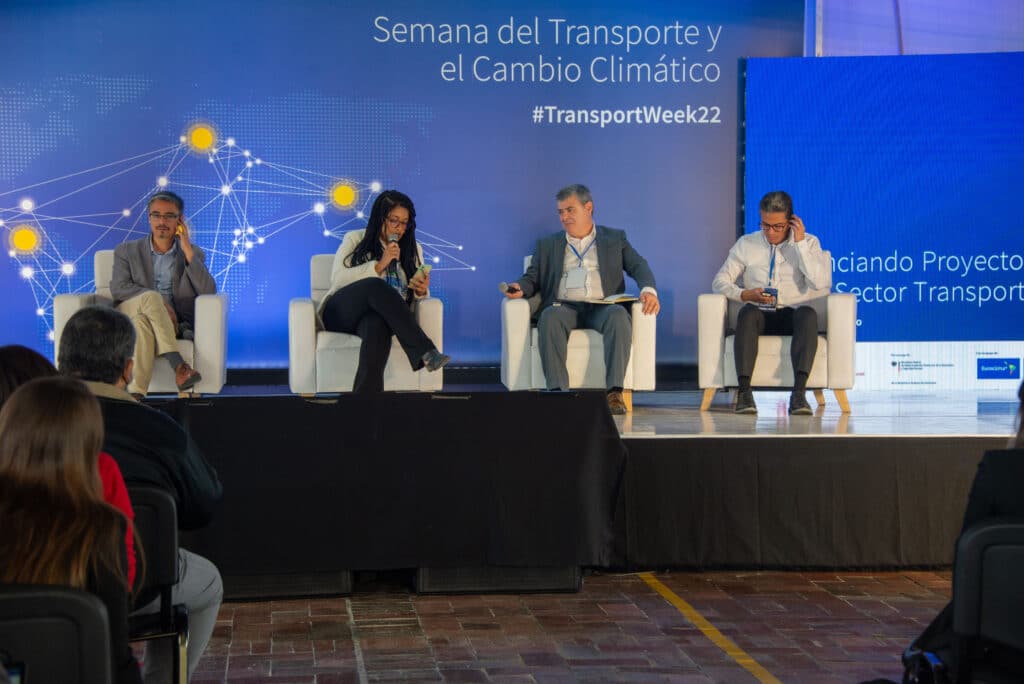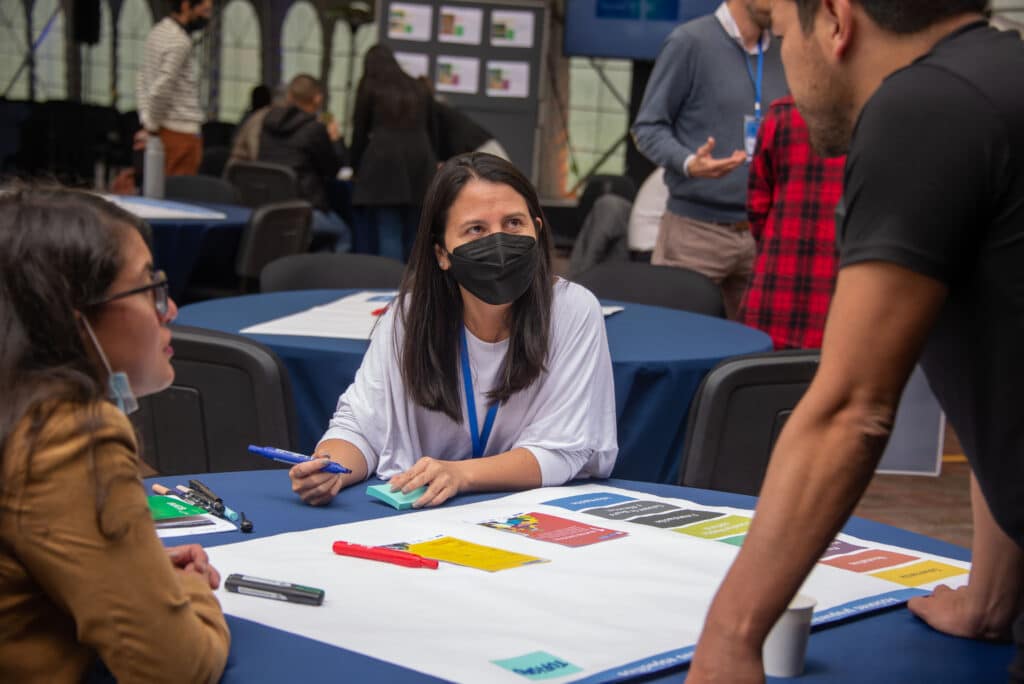
How can mobility develop its full potential to enable people an easy and safe access to opportunities without damaging their health and the environment or being an exacerbating factor of social inequalities? After two years of partial to near total confinement across the globe, the COVID-19 pandemic put a magnifying glass over the importance of SDG 11.2 in the UN 2030 Agenda. Never has there been a greater global need for safe, affordable, accessible and sustainable transport systems.
The sessions streamed from the Latin America Conference Hub of the 5th Transport and Climate Change Week in Bogotá shed light on the importance of AVOID (reducing trip distance) and SHIFT (to sustainable modes) and how they contribute to sustainable development.
At the welcome session Joseluis Samaniego, Director of ECLAC‘s Sustainable Development and Human Settlements Division, emphasized that countries have strengthened their ambition in the transport sector in their NDCs by 13%.
However, from a social impact perspective, the stimulus in fleet replacement benefits only 2% of the population, even though it has led to a significant and exemplary acceleration of electromobility. Hence, the relevance of putting people at the centre of the discussion was the driving theme during the whole week.
It is essential to develop mobility plans that address the need for coordination and joint planning and include a multimodal, inclusive, affordable and gender-sensitive approach.
Joseluis Samaniego (Director of ECLAC’s Sustainable Development and Human Settlements Division)
Active mobility is not only the motor for a greener, less energy-dependent transport system, that allows cities to decrease their pollution levels. It also allows different social groups – regardless of income, gender, age, and abilities – to access services, social networks or employment opportunities in an easy, affordable and safe way.
Latin America, in line with global trends towards transport decarbonisation and sustainable mobility, has been implementing transformative actions to improve the equitable distribution of public space for cyclists and pedestrians. The COVID-19 pandemic demonstrated the region’s resilience, and experimental initiatives such as emerging cycleways were conceived in response to the need for bio-healthy transport, with a special focus on care travels.
For example, the city of Bogotá provided around 117 km of temporary bicycle lanes, many of which became part of the city’s permanent network; Mexico City did the same with 54 km of temporary infrastructure for cyclists; and Buenos Aires pedestrianized 100 streets with the objective of promoting economic reactivation through neighborhood commerce.
Many other cities in the region replicated these initiatives while producing guidelines to promote social distancing and demand management for public transport. These initiatives reaffirmed the region’s leading position in promoting active modes and have served as an example for other countries in the world on issues related to sustainable mobility beyond the context of the pandemic.
How to reach a user-centred transportation system and how to encourage a modal shift towards more sustainable options? During the session “Beyond the objectives of the NDC: challenges to close the gaps” in Latin America, various speakers highlighted the necessity to adopt new legislation and regulatory measures.
Mexico, for instance, strengthened its planning norms and regulations. Diana Quiroz, Director of Public Policies, Ministry of Agrarian, Territorial and Urban Development (SEDATU) of Mexico, explained how guidelines can function as a positive accelerator of behavioural change. According to her, considerable progress has been made in the development of design guidelines and standardization of public space with a transversal and bioclimatic approach, under the principle of the 4S: health, safety, sustainability, and solidarity.
Alejandra Álvarez, coordinator of the formulation team of the National Active Mobility Strategy at the EAFIT University of Colombia, presented the challenges of incorporating a gender and differential perspective and the need of enabling stakeholders to manage multiple instruments, as well as to unify the vision of all actors participating in this transformation.
Citizens’ participation in the design of measures is the most direct way to gain knowledge on mobility patterns and social needs. This is of special importance for active mobility and mobility planning. In this regard, experts and practitioners from Peru, Chile and Colombia exchanged on their experiences with integrated planning (watch recording). A highly participatory and purposeful design with the community, social organizations and stakeholders ensures that people develop a sense of ownership of urban public spaces.
One of the biggest challenges is to gain citizens’ trust in planning instruments. This is the only way to keep the instruments alive, and thus increase citizens’ participation, contribute to a higher quality of life, give a clear signal to the private sector to get involved in sustainable development, and share the vision on projects and city planning.
María Jara Risco (Executive President of the urban transport authority of Lima and Callao, Peru)
Similar experiences have been made in other regions as. An exchange between Latin American and Asian cities (watch recording) highlighted how participation follows cultural patterns specific to the place. But even within one culture, different social groups participate in the community differently and benefit from the positive effect of active mobility unequally. Therefore, the discussion concluded that it is key to manage different expectations, e.g. ensuring spaces for women’s participation.
Innovative solution for active mobility and public transport was a cross cutting theme of different continents. E.g. the Cairo Bike Share System has significantly helped the Egyptian capital in advancing the implementation of a low cost and accessible public transport (watch recording). Bogotá was able to show how the Colegio de la Bici in Bogotá is offered to high school pupils as a complement to the general education programme (side visit in Latin America).
Such innovations need to be complemented by strategic frameworks to promote cycling and walking. Colombia for example drafted a National Active Mobility Strategy (ENMA) and will be published in the second half of 2022. Another example was Addis Abeba´s strategy for non-motorized mobility that outlined clear policies, political support, and well-articulated multilevel roles of agencies and authorities (watch recording).
Furthermore, gender and a differential perspective are fundamental to promote the use of more sustainable modes of transport. A panel on care as an essential axis for building an equitable mobility system (i.e., to pick up or drop off someone, to receive or offer health care, or to go grocery shopping) highlighted the difference in mobility patterns between women and men.
In Latin America, 9 out of 10 women are engaged in unpaid care activities, while only 6 out of 10 men are. Moreover, 90% of women who do this work as their main activity are low-income and low-schooled women.
Adriana Ruth Iza Certuche (Secretariat of Mobility of Bogotá)
Therefore, the proportion of women who travel for care purposes is significantly higher than that of men. Despite the above, data gaps on the issue are still significant as surveys are often not gender-sensitive.




Currently, international attention is very much focused on electric mobility. There remains a lack of funding for non-motorised modes. Benjamin Welle of WRI pointed out at the MobiliseYourCity session on “How to shape net-zero cities with active and public transport?” that cities should stop investing in large road infrastructure projects altogether. This, in turn, would free up public budgets that could be reoriented towards active mobility services and infrastructure.
Investments in active mobility infrastructure, commonly fall under the jurisdiction of local governments. Although there is a common perception that local public budgets that prioritize walking and cycling are either insufficient or virtually non-existent, we have seen that the right circumstances, coupled with political will, are usually enough to significantly ramp up efforts to build or re-purpose infrastructure for pedestrians and cyclists. The “Medio Milenio” bicycle highway in Bogotá implemented by the C40 Cities Finance Facility and GIZ is a good examples that highlight the need for a robust technical justification for the implementation of projects.
In addition, international financial institutions can provide additional financial support to governments. Ian Jennings, Senior Urban Transport Specialist at EBRD, explained that large infrastructure projects, especially mass transit, are useful instruments to leverage additional investments into active mobility – a point shared by James Leather, who stated the importance of pedestrian connectivity to mass transit services. Nonetheless, Ian Jennings argued that there is still a need to explore additional financial instruments, beyond traditional investments, through which international and development organizations can support local governments to promote walking and cycling.
If you are interested in more information, read the 8 key messages from experts on how to shape net-zero cities with active and public transport on the MobiliseYourCity website.
In further articles you can get more insights from different regions that have discussed various topics during Transport and Climate Change Week 2022.
Recordings of almost all sessions are accessible through the Programme on transportweek.org and available on the Changing Transport YouTube Channel. Find more impressions of the week on Flickr!
Mark you calendars: The next Transport and Climate Change Week will take place in September 2023.
The Transport and Climate Change Week was organised for the 5th time and is funded through the International Climate Initiative (IKI) of the German Federal Ministry for Economic Affairs and Climate Action (BMWK) and the German Federal Ministry for the Environment, Nature Conservation, Nuclear Safety and Consumer Protection (BMUV). It involves partners of GIZ and other implementing organisations and is organised by the Changing Transport Team of GIZ.
